News From the Festival
Utah House Recognizes Every Brilliant Thing Tour
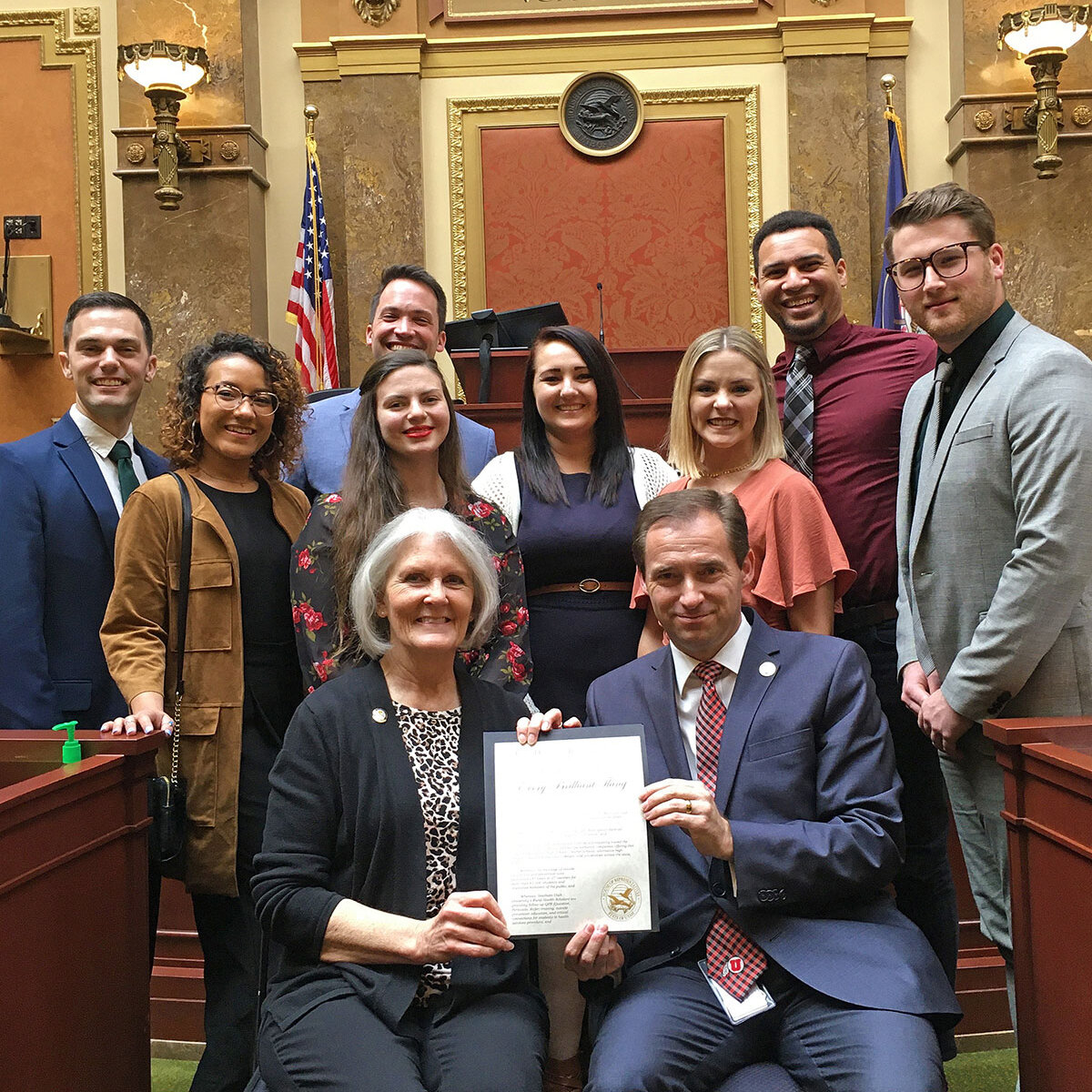
Utah State Representatives Elizabeth Weight (left) and Steve Eliason join the touring companies of Every Brilliant Thing with the official citation honoring the tour and the Festival.
On January 31, the Utah State House of Representatives honored the Utah Shakespeare Festival and its touring production of Every Brilliant Thing for its efforts in suicide prevention. The Festival has offered the play to every high school in the state for no charge.
Two touring companies left Cedar City in October with a goal to perform for as many schools as possible before the middle of February. Thus far it has taken its message of suicide awareness and prevention to more than 45,000 students with 147 performances in 27 counties.
The story of Every Brilliant Thing is simple on the surface. It begins when the lone character in the play, at seven years old, learns that his or her mother is in the hospital after her first attempt to take her own life. Thus, the character begins a list—a list of everything brilliant about the world, everything worth living for. With humor and inventiveness, the story then explores depression and hope, uncertainty and change, relationships and solitude, risk and resilience, guilt and forgiveness. And throughout it all, the protagonist increases the number of brilliant things on the list, and interacts with audience members to share this story of hope.
After the play, the actors and mental health professionals are available to talk to students and offer training, suicide prevention education, and critical connections for students to health service providers. In the end the play offers four clear messages:
1. You are not alone.
2. You are not weird.
3. It gets better.
4. Life goes on.
The citation recognizes the need for this type of programming, in that “the State of Utah has the highest rate of suicide for youth ten to twenty-four years old and ranks sixth highest in overall suicide rates in the nation.”
The citation concludes: “The Utah State Legislature recognizes the Utah Shakespeare Festival, the professional theatre company at Southern Utah University for its commitment to saving and changing lives through this unique theatrical event and congratulates the Festival on its efforts to be a positive force in communities and in the State of Utah.”
“This is a great honor, and producing this beautiful play across our great state wouldn’t have been possible without support from the Utah State Legislature and our wonderful partners that believed in the mission.” said Donn Jersey, Festival development and communication director. “This effort has saved and changed young lives for the better; for that reason alone, the Utah Shakespeare Festival could not be more proud of this memorable effort to deliver a message of hope to students all over our great state.”
“The student response has been phenomenal,” according to a report prepared by the two tour managers. “Utah students are so wanting to be heard and are willing to share life experiences with us and their peers.”
The citation also recognized the sponsors of the tour: the Utah State Legislature, the Utah Department of Heritage and Arts, the Utah Division of Arts and Museums, the Ashton Family Foundation, the Hemingway Foundation, Southern Utah University, and SUU’s Rural Health Scholars.
For more information on the tour, go to https://www.bard.org/brillianttour-info.
Festival's Hamlet Receives BroadwayWorld Regional Awards

BroadwayWorld recently announced the winners of its 2019 Salt Lake City regional awards, and the Utah Shakespeare Festival’s Hamlet walked away with an armload of prizes. The highly-praised Shakespearean tragedy won in the areas of Best Play, Best Direction, Best Actor, Best Lighting Design, Best Scenic Design.
In fact, Hamlet was recognized more than any other play in the non-musical category.
Regional productions, touring shows, and more were all included in the voting by audiences for plays that opened between October 1, 2018 and September 30, 2019. According to the BroadwayWorld website, 2019 had a record number of both nominations and votes.
Besides Best Play, other awards were for Brian Vaughn for best direction, Quinn Mattfeld for best actor, William C. Kirkham for best lighting design, and Jason Lajka for best scenic design.
The play was recognized throughout the 2019 season as a stunning interpretation and presentation of Shakespeare’s popular and soaring tragedy.
“We are very proud of the artists that worked on this play and all our plays during the 2019 season,” said Frank Mack, executive producer. “These awards recognize their creativity and hard work, as well as the work of our entire organization.”
The complete list of awards can be found here.
Educational Tour Once Again Hitting the Road

The Utah Shakespeare Festival is once again hitting the road with its Shakespeare-in-the-Schools touring production—this year performing one of the world’s most popular and tragic love stories, William Shakespeare’s Romeo and Juliet.
The tour will be performing nearly 60 shows for over 120 schools and 25,000 students across the states of Arizona, Wyoming, Colorado, Nevada, and Utah. The cast and crew will be on the road for thirteen weeks from January through April to bring this classic tragedy to schools, community centers, and correctional facilities. Students will have the chance to watch the show and then participate in a post-show discussion and workshops in Stage Combat, Performing Shakespeare’s Text, Technical Theatre and Developing Character through Improvisation.
Romeo and Juliet will present one public performance will be on January 29 at 7:30 p.m., in the Auditorium Theatre at Southern Utah University. General admission tickets are $5 and can be purchased at the Festival ticket office at 800-PLAYTIX (800-752-9849) or online at www.bard.org/tour. Tickets purchased ahead of time will be available at will call in the Auditorium Theatre. On the night of the performance, only cash and checks will be accepted at the Auditorium Theatre door, whereas credit and debit cards will be accepted at the Festival’s main ticket office next to the Anes Theatre. Admission is free for SUU students.
Jason Michael Spelbring, familiar to Festival audiences through his many acting and directing stints for Festival plays, is directing this production. He is associate professor in the Department of Theatre Arts at Utah State University–Caine College of the Arts and associate artistic director for Lyric Repertory Company. Directing credits include An Iliad at the Festival and Twelfth Night at the Conservatory of Theatre Arts at Webster University. He is a member of Actors’ Equity Association and Stage Directors and Choreographers Society
“For many of our audiences this will be the first time they have seen a professional Shakespeare production,” said Michael Bahr, Festival education director. “This program seeks to entertain, enrich, and educate with innovative and accessible performances to rural and urban schools and communities, many of which would not have this opportunity otherwise.”
Actors in the touring company include a number who have worked at the Festival, as well as professionally across the country. They are:
Ian Allred (Benvolio, Paris) recently received his BFA from Southern Utah University. He has appeared at the Utah Shakespeare Festival in Joseph and the Amazing Technicolor Dreamcoat, *Big River,*and The Greenshow.
Dane Michael Braddy (Romeo) is from Logan, Utah, where he also earned his BFA from Utah State University in 2019. Favorite credits include Levin in Anna Karenina, Paul in The (Obsolete) Unkindness of Ravens, Will Bloom in Big Fish, and Henry in Next to Normal.
Kenna Funk (Tybalt, Lady Capulet, Peter, Friar John) is attending Southern Utah University for her BFA in acting. SUU credits include Private Lives, Richard III, and Rosencrantz and Guildenstern Are Dead. She has appeared at the Utah Shakespeare Festival in Hamlet and Joseph and the Amazing Technicolor Dreamcoat.
Rachael Hodge (Nurse, Prince) is a recent graduate of Utah State University with a BFA in acting. Favorite credits include Mamma Mia! (Lyric Rep), Anna Karenina, Xanadu, Much Ado about Nothing (Utah State University), and Oklahoma!, Romeo and Juliet, The Drowsy Chaperone (MiraCosta Theatre).
Marena Kleinpeter (Juliet, Sampson) earned her B.A. in theatre arts from the University of Northern Colorado then relocated to Seattle to work with Intiman Theatre. She has worked at Seattle Public Theater, 5th Avenue Theatre, Edmonds Driftwood Players, LG! Theater, and GreenStage: Shakespeare in the Park.
Trey Plutnicki (Mercutio, Montague, Friar Lawrence) recently graduated from Otterbein University in Westerville, Ohio with a BFA in musical theatre. He has appeared at the Festival in The Greenshowand *Joseph and the Amazing Technicolor Dreamcoat.*Other credits include Otterbein Summer Theatre, Weathervane Playhouse, and Franklin Theatre Works.
Bailey Savage (Capulet, Balthasar) has worked in several roles with the Festival Education Department. She holds a BIS degree from Southern Utah University. She is a member of Jacaranda Collective, and previous credits include The Shakespeare Project of Chicago, Midsommer Flight, Intrinsic Theatre Company, and Lyric Repertory Theatre Company.
In addition, the tour company includes three technical and administrative artists:
Emily Cacho (Company Manager) is returning to the Festival for her fifth year. She has previously worked in the Festival’s Ticket Office as a ticket office supervisor. She is a recent graduate of Southern Utah University’s theatre arts program with a minor in arts administration.
Collin Hall (Technical Director) is a lighting designer and technician from Tennessee. She has worked for the Utah Shakespeare Festival for the past two summers as an electrician and has designed at such theatres as the Clarence Brown Theatre, Flying Anvil Theatre, Theatre Aspen, and Maples Repertory Theatre.
Jaclyn Pageau (Stage Manager) earned her BA in Theatre from Dartmouth College. Based in New York City, some of her favorite recent credits include *BrandoCapote,*Raylynmor Opera (Die Fledermausand Barber of Seville), and *Sigh No More,*as well as her work with Northern Stage’s education program
The Festival’s Shakespeare-in-the-School touring production is made possible by generous donations from the National Endowment for the Arts in conjunction with Arts Midwest, the Hearst Foundations, the Utah State Office of Education, Ally Bank, Mountain West Small Business Finance, and Southern Utah University.
Join Us for the Second Annual "Make a Scene"
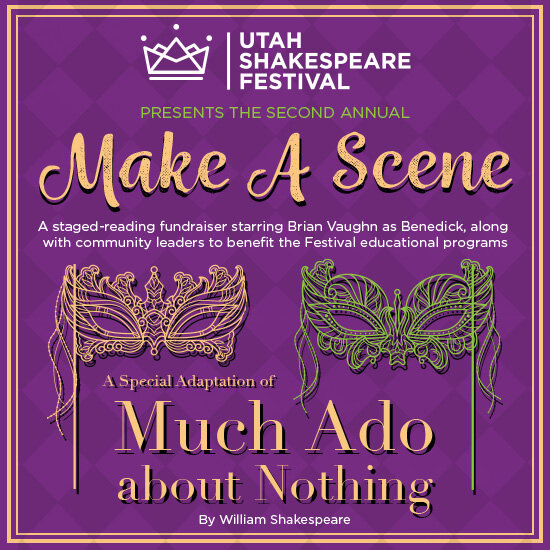
The Utah Shakespeare Festival is inviting everyone to join them in the second edition of the most popular fundraising event in its history. The second annual “Make a Scene” festivities will be March 5 at 6 p.m. in Harman Theatre in West Valley City—featuring an elegant dinner and stage appearances by Utah government, business, and media notables.
Harman Theatre is located at 3333 Decker Lake Drive in West Valley City.
The evening will feature a staged reading of a shortened version of the hilarious Shakespeare play Much Ado about Nothing. Festival Artistic Director Brian Vaughn will play Benedick, and Kymberly Mellen, a well-known actor at the Festival and across Utah, will play Beatrice, two of Shakespeare’s most famous and joyful combatants and lovers. Utah politicians, business leaders, and media personalities will fill in all the other roles: the evil Don John, the bumbling constable Dogberry and his hilarious deputies, the young lovers Hero and Claudio, and many more.
Cast members confirmed thus far include Governor Gary R. Herbert and First Lady Jeanette Herbert; Lieutenant Governor Spencer J. Cox and his wife, Abby; Senator Don Ipson; Mary Brown Malouf, executive editor at Salt Lake Magazine; Boyd Matheson, opinion editor at Deseret News; Carole Mikita, senior arts and religion reporter at KSL; Representative Rex Shipp; Senator Evan Vickers; and Representative Elizabeth Weight.
An elegant buffet dinner will proceed the performance.
“We did this event last year for the first time, and it was great fun. This year should be even better,” said Executive Producer Frank Mack. “After a beautiful dinner together, we will go into the theatre for a short, script-in-hand reading of Shakespeare’s Much Ado about Nothing, featuring unlikely performances by leaders of the business, government, and media communities in Utah—alongside great professional actors.”
This joyful play has been performed many times at the Festival, but our “guest stars” will bring a whole new level of hilarity and familiarity to the comedy as you recognize faces from various other business and government stages appearing on the show-biz stage of Harman Theatre.
“Performers from last year’s events included Lt. Governor Spencer J. Cox and Abby Cox; Doug Fabrizio from KUER; Evan J. Vickers, Senate majority leader; State Representative Patrice Arent; and many others,” said Development and Communication Director Donn Jersey. “Casting is on-going for this year, but we have a few surprise announcements to make in the coming weeks.”
“This is a uniquely fun way to raise critical funding for the Festival’s education programs,” added Mack. “I am grateful to everyone who supports this event, including our friends in West Valley City who do much to make the event so great.”
The ticket price is $275 and is all inclusive; no additional fundraising will be part of the event.
For information, the latest information, and to order tickets, visit bard.org/make-a-scene, call Director of Development Donn Jersey at 435-865-8002 or Development Associate Emily Duncan at 435-586-7877, or email jersey@bard.org.
Become a Playmaker! Youth Program Auditions Announced
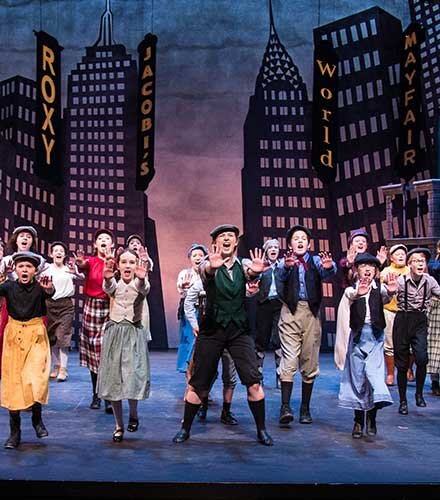
A Playmakers performance of Newsies!, 2019.
CEDAR CITY, Utah — The Utah Shakespeare Festival recently announced auditions and performance dates for its 2020 Playmakers production of Once upon a Mattress. The popular Playmakers program provides young actors a chance to rehearse, learn, and then perform this fun and popular musical.
Auditions will be January 9, starting at 3:30 p.m.; location is still to be announced, but the latest information is available at bard.org/playmakers. Youth ages six to seventeen are invited to audition.
Interested youth must reserve an audition time and should come prepared to sing one of three selected pieces. The audition reservations form and the song selections can also be found at bard.org/playmakers. An accompanist will be provided, and callbacks will be January 10 from 4 to 6 p.m. in the Southern Utah University Music Building, room 209.
In addition, the Festival is offering an audition workshop on January 8, from 4 to 6 p.m., also in the SUU Music Building, room 209. Hopeful actors can come and play theatre games, get to know the Playmakers team, and learn the audition songs. There is no cost to attend. Attendance at the workshop isn’t required, but is highly recommended.
“If your child has questions,” said Festival Education Director Michael Bahr, “this is a great way to get to know the program.”
Once auditions are completed and participants are announced, rehearsals will begin on January 14 and extend through the opening performance on April 1 School performances of Once upon a Mattress will be April 1, 2, 3, and 6, with special public performances on April 3, 4, and 6.
The program trains youth in theatre fundamentals, including how to sing and dance with a live piano, rehearsal and performance etiquette, and how to work, share, give, and play with others.
Once upon a Mattress is a comedy with music by Mary Rodgers and lyrics by Marshall Barer. It opened on Broadway in 1959 and has garnered numerous awards. It is a musical adaption of Hans Christian Andersen’s fairy tale The Princess and the Pea. It is a jazzy, lyrical love-story of a spunky, charismatic, and original princess who finds love through a series of innovations and mishaps. The whole ensemble, comprised of intelligent, courageous ladies, caring and chivalrous knights, imaginative jesters and minstrels, tell the story through live music and dance.
“I love this musical,” said Bahr. “It is a jazzy, fractured fairy tale that requires unique actors to portray strong and spunky characters. The play is perfect for training artists in the fundamentals of the theatre.
For more information and to schedule an audition, visit bard.org/playmakers.
Festival Announces 2020 Season Directors
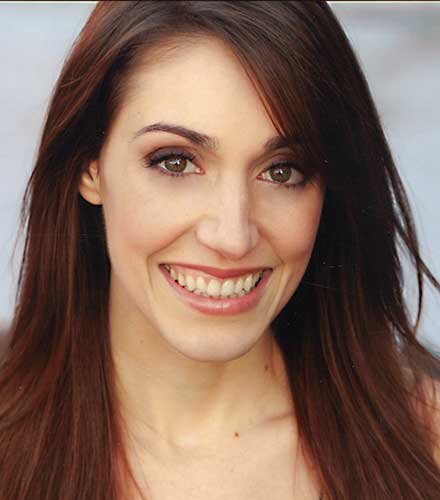
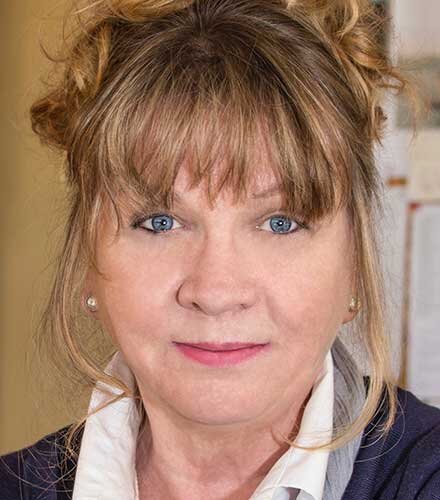

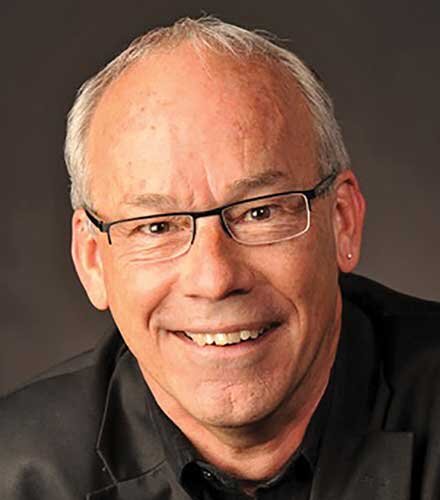




Cassie Abate
Kate Buckley
Vincent J. Cardinal
Brad Carroll
Britannia Howe
Melinda Pfundstein
Kent Thompson
Brian Vaughn
“The cry is still ‘they come,’” said William Shakespeare’s Macbeth; but it could just as easily have been Utah Shakespeare Festival Artistic Director Brian Vaughn as he recently announced the slate of directors for the Festival’s 2020 season. These creative and talented directors come to the Festival from home bases in Texas to Tennessee, in California to Colorado to Cedar City—and others across the country.
“I can’t wait to collaborate with each of these exciting directors,” said Vaughn in making the announcement. “Their collected artistic excellence is a shining example of the wonderful work on display here at the Festival, and I’m eager to share their vision with our audience.”
The 2020 season directors are:
Cassie Abate will be working at the Festival for the first time, directing and choreographing Gilbert and Sullivan’s hilarious operetta The Pirates of Penzance. She was assistant choreographer off-Broadway for The Brain from Planet X at the New York Music Festival and has directed and choreographed at theatres across the country, including Connecticut Repertory Theatre, Barrington Stage, ZACH Theatre, Redhouse Arts Center, the Steven Sondheim Center, and Theatre Workshop of Nantucket. She was also the associate choreographer for the world premiere of the new musical The World According to Snoopy.
“I am incredibly excited to be directing at the Utah Shakespeare Festival this summer,” she said. “The Pirates of Penzance is satire and parody at its finest full of whimsy, humor, and wit. While the show parodies many conventions of grand opera, the music parallels the best from the genre: it is both a burlesque and a love letter.”
Kate Buckley is returning to the Festival to direct Shakespeare’s dramatic history, Richard III. During past Festival seasons, she has directed Much Ado about Nothing, Romeo and Juliet, The Merry Wives of Windsor, Julius Caesar, Mary Stuart, and Othello.
She has also directed regionally at the Goodman Theatre, Oregon Shakespeare Festival, Milwaukee Repertory Theatre, American Players Theatre, Kansas City Repertory, Chicago Shakespeare Theatre, and others and internationally at the National Theatre of Slovakia and Colla Marionette Company in Milan, Italy. She is a founding member of the Chicago Shakespeare Theatre and is currently an associate professor of theatre at the University of Tennessee, Knoxville.
Vincent J. Cardinal is also returning to the Festival; he will be directing Shakespeare’s slapstick The Comedy of Errors. In the past he has directed Every Brilliant Thing and The Foreigner at the Festival. He has worked off-Broadway at Circle Repertory Company and at numerous other theatres, including Connecticut Repertory Theatre, Redhouse at City Center, Bucks County Playhouse, Theatre Aspen, Monomoy Theatre, and Cleveland Public Theatre.
Cardinal said he is honored to be returning to the Festival and describes The Comedy of Errors as “both rollicking farce and classic romance, a story of hysterical mistaken identity and a tale of a family, torn apart by misfortune, in search of each other.”
Brad Carroll, who directed Joseph and the Amazing Technicolor Dreamcoat in 2019, returns in 2020 to helm the new (and hilarious) musical Desperate Measures. Past directing credits at the Festival include South Pacific, Anything Goes Les Misérables, Spitfire Grill, H.M.S. Pinafore, Man of La Mancha, and several others. He was also the composer for the new musical Lend Me a Tenor: The Musical, which premiered at the Festival in 2007. He has also worked at numerous other theatres, including PCPA, Utah Festival Opera, Idaho Shakespeare Festival, and Anchorage Opera.
**“**Returning to the Festival always feels like coming home. And the opportunity to create alongside people of such passion and artistry makes the work not only rewarding, but an absolute pleasure,” said Carroll. “Desperate Measures is, in short, a wild west musical comedy romp, loaded with surprises and highly entertaining. Not to be missed!”
Britannia Howe, who directed The Greenshow in 2018 and 2019, returns to helm the popular pre-show entertainment again, as well as direct Shakespeare’s Cymbeline. Besides work at the Festival, Howe has also worked at Eugene O’Neill Theater Center, Cabaret Theatre, Innovative View Theatre, Women of Will, and Illinois Shakespare Festival. She is a recipient of the Kennedy Center American College Theatre Festival National Directing Fellowship and is currently working on her MFA in directing at Illinois State University.
“Having grown up as a groundling at the Utah Shakespeare Festival, I attended productions and observed the great directors, designers, and actors. As a young girl I would peer over the back wall of the Adams Theatre to watch the plays,” said Howe. “Utah Shakes shaped me into the artist I am today, and for that reason I am thrilled to be returning to Cedar City.”
Melinda Pfundstein, well known as both an actor and director to Festival guests, is returning in 2020 to direct the warm and hilarious Into the Breeches! She directed The Book of Will and The Merchant of Venice at the Festival and has appeared as an actor in such diverse roles as Hermione in A Winter’s Tale, Roxane in Cyrano de Bergerac, Eliza Doolittle in My Fair Lady, and Fantine in Les Misérables. She has also worked at Milwaukee Repertory Theatre, Renaissance Theaterworks, and Nevada Conservatory Theatre. She is the founding executive director of StateraArts, a national advocacy nonprofit serving women in theatre.
“I am over the moon about returning to the Festival to explore this story about survival and resiliency, through moments at once comedic and then deeply moving,” said Pfundstein. “This play is a celebration of theatre and community. It is a reminder that you are enough. That together we are enough.”
Kent Thompson is directing Pericles this year. He last directed at the Festival in 2012 (Scapin), and before that led The Imaginary Invalid (1989), Cymbeline (1988), and The Comedy of Errors (1987).
He directed A Lesson Before Dying off-Broadway at the Signature Theatre Company and has served as producing artistic director at both Denver Center Theatre Company and Alabama Shakespeare Festival. His book Directing Professionally: A Practical Guide to Developing a Successful Career in Today’s Theatre was published in January. He has also directed at Company of Fools, Ruskin Group Theatre, Central City Opera, Goodspeed Musicals, Geva Theatre Company, the Stratford Festival, Boston Shakespeaer Company, North Carolina Shakespeare Festival, Delaware Theatre Company, New Stage Theatre, Virginia Shakespeare Festival, and many others.
Brian Vaughn, the Festival’s artistic director and popular director and actor will be directing both One Man, Two Guvnors, a frenetic, modern adaptation of Goldoni’s The Servant of Two Masters; and Shakespeare’s Worst!, a new play which was workshopped in 2018 as part of the Festival’s Words Cubed new play program.
Over more than twenty-five years at the Festival, Vaughn has directed such shows as 2019’s critically-acclaimed Hamlet, as well as Shakespeare in Love, Henry V, Henry IV Part Two, Henry IV Part One, Peter and the Starcatcher, Dial M for Murder, and Greater Tuna. As an actor, he has appeared in over forty roles including title roles in Hamlet, Henry V, and Cyrano de Bergerac, as well as The Poet in An Iliad, Brad in How to Fight Loneliness, Sky Masterson in Guys and Dolls, Oscar Madison and Felix Ungar in The Odd Couple, Petruchio in The Taming of the Shrew, Charlie in Stones in His Pockets, and Javert in Les Misérables.
“This extraordinary group of professional artists will lead the producing process for our 2020 season,” said Frank Mack, executive producer. “They represent some of the best theatre artists from across the country. and I am excited to see the amazing productions they will help create next season.
Tickets for the 2020 season are now on sale: visit the Festival website at bard.org, call 800-PLAYTIX, or visit the Ticket Office at the Beverley Center for the Arts.
Festival Donates Nearly Two Tons of Food to Care and Share
Cedar City, UT – Utah Shakespeare Festival guests made life a little better for those in need this fall, by donating nearly two tons of food to the Iron County Care and Share. The food was donated as part of the Festival’s seventeenth annual Fall Food Drive from September 16 to October 12. Residents of southern Utah and eastern Nevada were able to donate six items of nonperishable food and receive a half-price ticket to a Festival production.
In total over 3,600 pounds of food was donated for the less fortunate in our community. Residents of Iron, Washington, Kane, Garfield, Sevier, Piute, and Beaver counties in Utah took part in the drive, as well as guests from Lincoln County, Nevada.
“We are humbled and grateful to our community members for their support of this effort,” said Donn Jersey, director of development and communications. “The Festival’s annual fall food drive started in 2003, and over the years our guests have consistently demonstrated their generosity and caring in support of those in need, and we couldn’t ask for a better community partner than the Iron County Care and Share.”
The Iron County Care and Share was founded in 1984 by a group of local churches of different denominations to address the issue of hunger in our community. Working with partners in the community, neighboring counties, and in the state, the Iron County Care and Share is able to help homeless and low-income individuals and families work toward self-sufficiency. The Iron County Care and Share is located at 900 North 222 West Cedar City, Utah.
The Utah Shakespeare Festival is part of the Beverley Taylor Sorenson Center for the Arts at Southern Utah University, which also includes the Southern Utah Museum of Art (SUMA).
Living with Hamlet: Part Three
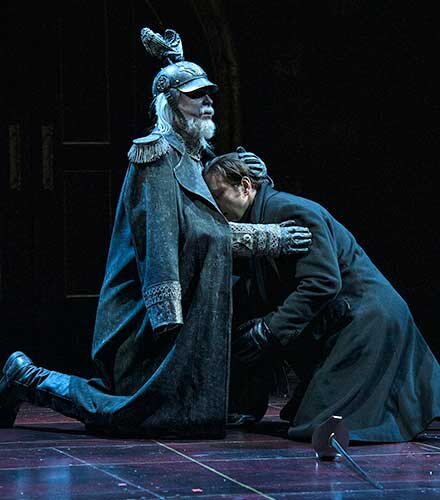
John G. Preston (left) as Ghost of Hamlet’s Father and Quinn Mattfeld as Hamlet.
By Quinn Mattfeld
Editor’s Note: This is the last of three blog posts written by actor Quinn Mattfeld about playing the towering role of Hamlet this year at the Utah Shakespeare Festival.
Long ago when I was a young, impressionable actor, someone (I don’t recall who) told me that there is only one question in Hamlet: “Is the ghost real?” Thankfully, as a less impressionable and less young actor, I now know that this is not the only question. In fact, I don’t think it is a question at all.
The ghost is real. The question probably isn’t.
Horatio sees the ghost. As do Marcellus and Bernardo. If the ghost is, as Gertrude worries, an invention of Hamlet’s brain, then these characters must also be projections of Hamlet’s mind, as would all the characters with which they interacted and so on until everyone in the theatre except Hamlet is imaginary. This includes, of course, the audience as they too have seen the ghost.
In order to make sense of the play—to engage in good faith with all of its questions and infinite potential we have to accept the circumstances that the playwright gives us.
Another question which haunts any portrayal of the Dane is whether or not he has gone mad.
In this case we get a clear and definitive answer from the character himself. After encountering the ghost, Hamlet tells Horatio and Bernardo, “I perchance hereafter shall think meet to put an antic disposition on” and later confides to Gertrude, “I am not in madness but mad in craft.”
As unequivocal as the answer initially appears, unlike the existence of the ghost, Hamlet’s madness is, I think, somewhat amenable to interpretation. There is no doubt that Hamlet deliberately feigns madness in order to conceal his revenge-plot against Claudius. Yet throughout the play he is repeatedly warned by those closest to him about the danger of losing his mind in that pursuit. As the ghost beckons Hamlet to follow him further into the wilderness, Horatio tells Hamlet that the spirit may, “deprive your sovereignty of reason and draw you into madness.” Adding pointedly, “Think on it.” And then, one scene later the ghost itself concludes his charge to Hamlet with this special observance, “taint not thy mind.” And again, before Hamlet reveals his method therein, Gertrude warns her son about his madness with, “This is the very coinage of your brain. This bodiless creation ecstasy is very cunning in.”
So while we can say definitively that Hamlet is affecting madness, it’s not entirely clear that madness isn’t also a very real danger for him. It seems to strike exactly no one in Elsinore as a shock that Hamlet has gone mad, and it therefore makes a great deal of sense that he would employ that very device to inoculate himself against suspicion.
The Prince often describes himself as a victim of his own thoughts, bemoaning to Rosencrantz and Guildenstern his “bad dreams” and the rotting state of Denmark, “there is nothing either good or bad but thinking makes it so. To me, it is a prison.” And when he is alone, Hamlet is relentless in the prosecution of his own mind, concluding in “To be or not to be,” that “conscience does make cowards of us all,” and that “resolution is sicklied o’er with the pale cast of thought.” In preparation for his exile in England, Hamlet finally sheds the paralysis within his own head by naming it, “some craven scrupel of thinking too precisely on the event.”
Indeed, up until this point in the play, he seems to have a great deal of trouble containing his thoughts and in particular with Ophelia and Gertrude. They are arguably the two most important people in his life and neither can get more than a few words in while alone with him. Hamlet’s mind collapses into an obsessive pattern of enumerating his grievances against them and himself, “I am very proud, revengeful, ambitious and with more offenses at my beck than I have thoughts to put them in, imagination to give them shape, or time to act them in.”
It’s as if he just can’t stop himself.
Has he always been like this? Was Hamlet the young prince that all of Elsinore whispered and worried about? When Hamlet bursts into Ophelia’s room, does he know that she will run to tell her father, and in no time, the fear of his madness will be converted into a fact by the loquacious pedant Polonius?
If so, Hamlet is using the court’s calumny against itself, and for an actor the question of Hamlet’s madness becomes a very useful one—a tactical one. The question of the ghost, not so much.
If we accept the given circumstances that Shakespeare offers us, questioning leads us to a place of discovery and choice. If we instead turn the questions against the given circumstances themselves, the play quickly descends into nebulous illogic and absurdity.
High School Competition Oct. 3–5

From October 3 to 5 over 3,500 students from more than 130 schools in eight states will descend on the Utah Shakespeare Festival and Southern Utah University as part of the forty-third annual Shakespeare Competition, the largest scholastic Shakespeare competition in the country.
While here, they will compete in acting, dance/choreography, music, and technical theatre before panels of industry professionals. They will also participate in workshops such as stage combat, improvisation, movement, technical theatre, auditioning, ballet, modern dance techniques, and choral performance, as well as attend Festival and SUU plays. At the end of three days, winners will be announced and trophies and scholarships handed out.
“For more than four decades this event has changed the lives of aspiring young students from all over the United States,” said Michael Bahr, Festival education director. “I’m looking forward to continuing this great tradition of theatre, dance, and music.”
Competitors range from sixth grade to high school seniors. Each participating school is invited to prepare monologues, two duo/trio scenes, and ensemble scenes, as well as an interpretive dance, minstrel and madrigal music. Technical theatre students will also compete in the numerous “backstage” areas of theatre, where they will be tested and trained in lighting, audio, set construction, props, rigging, costumes, hair and makeup, and stage management. Performing on Festival stages and in many classrooms on the SUU campus, students are adjudicated by professional actors, directors, dancers, musicians, and artists.
Donn Jersey, director of development communications said, “Anyone attending the Shakespeare Competition will clearly see the passion and exuberance these students demonstrate for theatre, dance, and music. They will be the future leaders of the arts, and this competition gives them the tools necessary to believe in themselves and in their art.”
Further information is available at the Festival website: bard.org/competition.
Hamlet Like You've Never Seen It Before
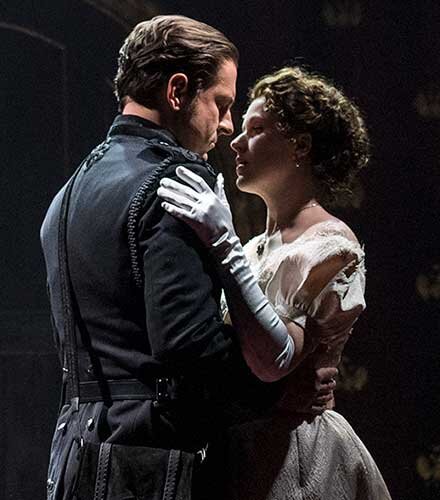
Quinn Mattfeld (left) as Hamlet and Emma Geer as Ophelia.
By Kathryn Neves
Odds are, if you’ve ever visited the Utah Shakespeare Festival, seen The Lion King, or attended a high school English class, you’re familiar with the story of Hamlet. The tale of a Danish prince, a ghost, a murderer, and an impending war is immediately recognizable to millions of people around the world. It is, after all, one of Shakespeare’s best—and most popular—plays.
With that in mind, it might be easy to say, “Oh, I’ve seen Hamlet. I know this story. Why should I go see it again?” The answer to that is simple: you’ve never seen Hamlet like this before. The Utah Shakespeare Festival’s 2019 production of Hamlet, directed by Brian Vaughn and starring Quinn Mattfeld, is an astounding piece of theatre that casts the story of Hamlet in a brand-new light. Whether you’ve seen Hamlet once or a hundred times, it’s worth seeing again for this interpretation. In fact, Russell Warne, reviewing the play for Utah Theatre Bloggers Association, says this production “is endlessly rewarding to watch.”
One of the aspects of this show that especially stands out is its setting. Immediately upon entering the theatre, you can see the signs of Imperial Russia: the costumes, the set, and the snow piled on the stage all work to transport you back to the time of czars and revolutionaries. Vaughn explains that this show is not necessarily “a realistic Russia, but a fictional Denmark similarly woven toward a kingdom under age-old repression, arbitrary rule, and an extreme sense of nationalism—resonating anger, divisiveness, and despair.” The changed setting of the play speaks well to Shakespeare’s universality: the story of a Danish prince seeking to avenge his father feels real and significant in any time period.
Beyond that, Hamlet’s themes of corruption, espionage, and tyranny fit very well in a Czarist Russia setting. “I was very intrigued by Claudius and his appeal to the masses; but, underneath, this is a king who is leading by fear, repressing the truth, and using murder as a tactic to keep the truth at bay,” said Vaughn. The setting “helps isolate the lone figure of Hamlet, trying to discover the truth in this very fictitious landscape. Hamlet is mining for the truth underneath the layered façade.”
But it isn’t only the changed setting that makes this show worth seeing. This production brings the oft-overlooked character of Ophelia (played by Emma Geer) into a much more prominent role. Too often, productions of Hamlet tend to cast Ophelia aside as merely a victim of circumstance, a damsel-in-distress subject to the whims of the powerful men around her. However, in this production, Ophelia takes on more significance—as a confidante, an ally, and a key part in Hamlet’s quest for the truth. “I wanted an Ophelia of great agency, who is deeply in love with Hamlet, and a Hamlet who is deeply in love with her,” says Vaughn. “I wanted an Ophelia who was like Hamlet: intelligent, strong, and curious and who is helping Hamlet expose the truth in this court. Through her madness she exposes those around her to the machinations that they undergo to try to keep her and Hamlet at bay.”
All this, of course, makes Ophelia’s death in the play far more powerful and gives it an entirely new meaning. Without giving too much away, Vaughn’s interpretation shows Ophelia’s drowning as a powerful result of the duplicitous nature of the play’s characters, and even of the play itself. “I wanted to add another layer to this corrupt kingdom,” says Vaughn. “What is truth and what is fiction? . . . Gertrude reports the drowning of Ophelia, . . . and why didn’t Gertrude do anything about it?”
This nuanced and layered Hamlet is enhanced by several of the staging effects. Snow piled across the stage and sometimes falling from the sky creates a striking effect that serves to emphasize the ever-present corruption of the court. It also illustrates the mental state of Hamlet himself. During one of his particularly compelling soliloquies, snow begins to fall from high above the stage. Vaughn explains, “I was very interested in . . . how the elements run in harmony with Hamlet’s vulnerability in that moment . . . it’s one of my favorite moments, as Hamlet is at his most vulnerable, and the snow became a metaphor for the truth that will never leave him. Hence its prescience in the scenic design. It is always present, just like the truth. You can push it to the corner, but it will always be there.”
Rest assured, even if you know Hamlet well, this production will still surprise you. The beautiful stage design, the phenomenal acting, and the overall direction of the show come together to create a Hamlet unlike anything you’ve seen before. The Independent reviewer Brian Passey, agrees; the show “might just be the best version of the Bard’s beloved play you’ll ever see.” And it’s true; you’ll leave the theatre feeling as though you’ve just heard Shakespeare’s immortal words for the very first time.


